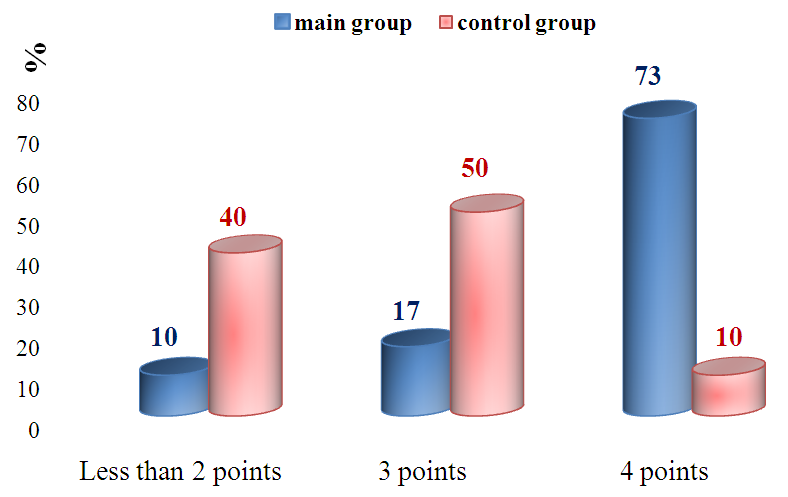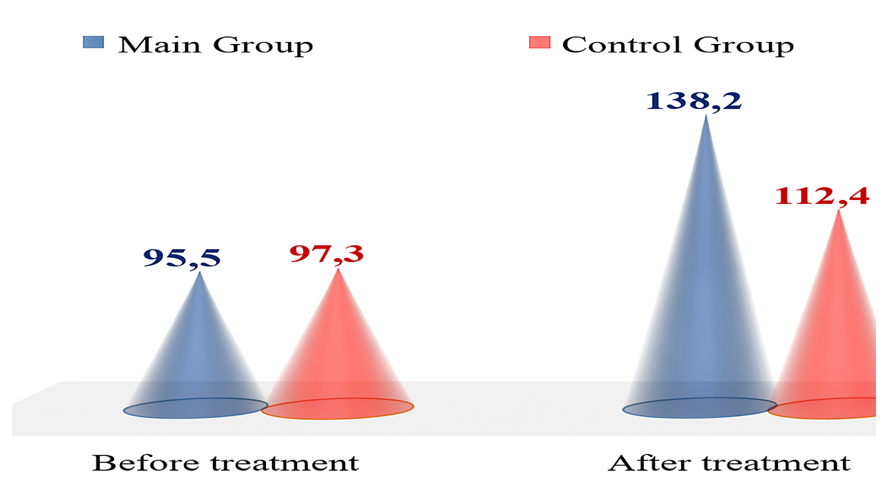-
Paper Information
- Next Paper
- Previous Paper
- Paper Submission
-
Journal Information
- About This Journal
- Editorial Board
- Current Issue
- Archive
- Author Guidelines
- Contact Us
American Journal of Medicine and Medical Sciences
p-ISSN: 2165-901X e-ISSN: 2165-9036
2025; 15(6): 2049-2052
doi:10.5923/j.ajmms.20251506.93
Received: May 28, 2025; Accepted: Jun. 16, 2025; Published: Jun. 23, 2025

The Critical Role of Contemporary Information Technologies in Enhancing Screening Procedures for Patients Undergoing Management of Chronic Non-Communicable Diseases
Khodjieva Gulirano Sayfullaevna1, Axmedov Nodir Ilxomovich2
1PhD., Bukhara State Medical University, Uzbekistan
2Bukhara State Medical University, Uzbekistan
Correspondence to: Khodjieva Gulirano Sayfullaevna, PhD., Bukhara State Medical University, Uzbekistan.
| Email: |  |
Copyright © 2025 The Author(s). Published by Scientific & Academic Publishing.
This work is licensed under the Creative Commons Attribution International License (CC BY).
http://creativecommons.org/licenses/by/4.0/

This article describes the results of a study on the adaptation, implementation and evaluation of the effectiveness of the MyTherapy mobile application in the practice of treating chronic non-infectious diseases in order to monitor treatment and patient compliance. Based on the more pronounced positive dynamics of the therapy itself, the improvement in the quality of life indicator and the indicator of adherence to treatment, it is shown that the use of this mobile application can be a highly effective method of monitoring the therapy of chronic non-infectious diseases when used correctly.
Keywords: Anemia, Compliance, Therapy control, Mobile applications
Cite this paper: Khodjieva Gulirano Sayfullaevna, Axmedov Nodir Ilxomovich, The Critical Role of Contemporary Information Technologies in Enhancing Screening Procedures for Patients Undergoing Management of Chronic Non-Communicable Diseases, American Journal of Medicine and Medical Sciences, Vol. 15 No. 6, 2025, pp. 2049-2052. doi: 10.5923/j.ajmms.20251506.93.
1. Introduction
- According to UNICEF multicenter studies conducted in Uzbekistan in 2017, approximately every seventh child in the country (15.6%) suffers from anemia. At the same time, 1% of patients have a severe form of anemia among chronic non-infectious diseases. About 20.3% of women of reproductive age and 32.7% of pregnant women also had severe symptoms of anemia [1,2]. The study of patients' attitudes towards prescribed therapy and the degree of its compliance is a fairly new area of scientific research. The development of this direction is due to the large role of the paradigm of interaction between the doctor and the patient, the transition from the paternalistic model to partnerships and the patient’s awareness of his own active role in therapy [3,4,5,6].Inadequate adherence to medications is a likely cause of treatment failure in chronic noncommunicable diseases. Patient adherence, or compliance, to treatment is usually defined as the degree to which patients comply with doctors' instructions [7,8,9]. Insufficient compliance is a common phenomenon and a problem for healthcare systems in many countries. According to WHO, in developed countries only 50% of patients suffering from chronic diseases strictly follow medical recommendations for a long time; in developing countries the figure is even lower [10,11,12].The beginning of the third decade of the 21st century was characterized by the rapid development and proliferation of electronic “gadgets” in all aspects of society. In this regard, one of the most relevant areas of medicine today is to improve the process of diagnosis, treatment and prevention of various diseases through the introduction of special mobile applications. The huge advantage of such software is that “gadgets” (smartphones, tablets, laptops, smart watches) are in the hands of the average person, according to sociological studies, for 12-16 hours a day, which determines their high potential in terms of impact on the patient.Purpose of the study. Adaptation and implementation of modern mobile software applications designed to monitor medication intake in the treatment process of patients with chronic non-communicable diseases, and assessment of their effectiveness in terms of increasing patient compliance.
2. Material and Research Methods
- The study included 60 patients with moderate iron deficiency anemia (hemoglobin level 90-70 g/l). The average age of the patients was 24.23±3.42 years. Gender distribution: 48 women (80%) and 12 men (20%).All patients received outpatient treatment of the pancreas. The study included only patients taking pancreatic Fe (III) (iron hydroxide polymaltosate) in order to exclude the influence of side effects from taking drugs (in the case of pancreatic Fe (II)), which may affect patient compliance. During treatment, patients included in the sample under consideration took various trade names of Fe(III) pancreatic acid, among which the most frequently used were Maltofer and Ferrum Lek. In addition to taking pancreatic acid, ascorbic acid preparations or multivitamin complexes were prescribed.To assess the effectiveness of using a mobile application for compliance monitoring, patients were divided into 2 groups homogeneous by age and gender ratio:- the main group included 30 patients whose therapy compliance was monitored using the MyTherapy mobile application;- the control group included 30 patients whose anemia was treated without compliance control.There are more than 10 applications available on the Internet for monitoring medication intake, the interface and functionality of which can be used to improve patient compliance in the treatment of chronic non-communicable diseases. We chose the MyTherapy application. This application is distributed on the Internet and is available for free download on devices running on both Android and IOS. The application has a fairly wide range of functions.First of all, you can enter information into the application about taking the drug, its form, frequency of administration, time of administration and duration of treatment. After entering the appropriate information about the time of taking the drug, a special signal will be triggered in the form of music or other sound, which will announce the time of taking the drug. When a signal appears, the application requires confirmation of taking the drug, which is important for recording compliance or non-compliance with the doctor’s prescription. Daily drug intake is recorded and stored in the form of a report (in pdf format), which can subsequently be printed or emailed to the attending physician.In addition to reminders about taking medications, you can enter notifications into the application about visiting a doctor, taking a test, and taking any preventive measures (gymnastics, walking, etc.), the registration and implementation of which will also be recorded in a special report.You can enter the results of various measurements and analyzes in a separate section. A separate section is devoted to checking the symptoms of the disease, which is important in monitoring the dynamics of therapy and its effectiveness.During the study, this application was installed on the smartphones or tablets of all patients with anemia who were included in the study. After installing the mobile application, the doctor entered the names of the drugs, their dose, dosage form, time of administration and duration of therapy (3 months for all patients). The dates of repeated visits to the doctor (once a month), the dates of donating blood to determine hemoglobin levels (once a month), and the dates of donating blood to determine ferritin levels (before the start and after the end of the course of ferrotherapy) were separately noted.To provide reminders, the applications included precisely those activities that most patients often neglect to complete. Nevertheless, these measures are of great importance in monitoring the course of pancreatic therapy and comply with generally accepted standards.During therapy, all patients included in the main group notified the doctor weekly about the progress of therapy by sending a report on taking the pancreas and completing other instructions via the Telegram messenger. To assess the effectiveness of ferrotherapy, patients were administered a questionnaire to assess adherence to therapy using the Morisky-Green questionnaire. To assess the quality of life (QoL) in patients with anemia, the FACT-An (For patients with anemia/fatigue) questionnaire was used. Also, during the 3-month follow-up, patients’ visits to the doctor and relevant tests were recorded.Statistical processing of the obtained data was carried out using the Microsoft Excel statistical software package. Data are presented as means and error of the mean.
3. Results
- Analysis of the average number of missed pancreatic doses showed that during the first month of therapy, patients in the main group missed pancreatic doses 6.8±2.1 times, while in the 3rd month the indicator improved significantly and amounted to 2.4±1.8 missed meals per day. average Analysis of the average number of late appointments during the first month was 14.2 ± 4.3 times, and in the third month it was 6.3 ± 3.2 times. Analysis of the average number of missed doses of vitamin preparations showed that during the first month of therapy, patients in the main group missed taking PZ 12.5 ± 3.5 times, while by the 3rd month the indicator improved significantly and amounted to 4.4 ± 2.6 omissions average. Analysis of the average number of untimely intakes of vitamin preparations during the first month was 17.7±4.4 times, and in the third month it was 8.3±3.7 times (Table 1).
|
 | Figure 1. Results of adherence assessment using the Morisky-Green scale in patients after 3 months of therapy |
 | Figure 2. Results of assessing the quality of life of patients over time |
4. Conclusions
- Observations of patients receiving treatment for 3 months showed that patients in the main group had significantly higher compliance rates according to the Morisky-Green scale, a more pronounced increase in hemoglobin levels in the blood and higher quality of life indicators compared to patients in the control group. Based on the demonstrated effectiveness, accessibility and simplicity, the proposed method can be recommended for implementation in widespread medical practice.
 Abstract
Abstract Reference
Reference Full-Text PDF
Full-Text PDF Full-text HTML
Full-text HTML